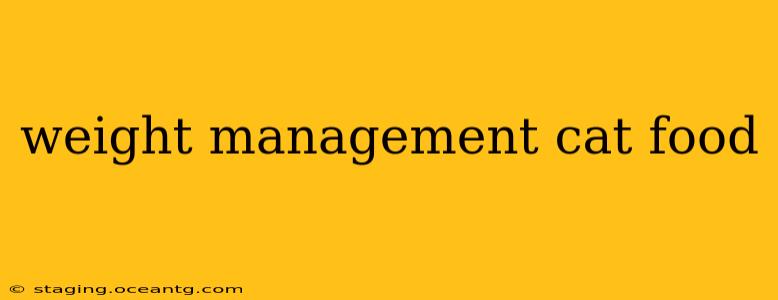Is your cat carrying a little extra fluff? Many cat owners face the challenge of managing their feline friend's weight. Obesity in cats is a serious concern, leading to various health problems like diabetes, arthritis, and heart disease. Choosing the right weight management cat food is crucial in helping your cat shed those extra pounds and live a longer, healthier life. This guide will delve into the key aspects of weight management cat food, answering your burning questions and providing actionable advice.
What is Weight Management Cat Food?
Weight management cat food is specially formulated to help overweight or obese cats lose weight safely and effectively. Unlike regular cat food, these diets typically contain:
- Reduced Calories: Fewer calories per serving mean your cat consumes less energy than it burns, leading to gradual weight loss.
- Increased Fiber: High-fiber ingredients promote satiety, keeping your cat feeling fuller for longer on fewer calories. This can help curb overeating.
- Higher Protein Content: Protein helps maintain lean muscle mass while aiding in weight loss. It also keeps your cat feeling full and satisfied.
- Controlled Fat Levels: Reduced fat content contributes to fewer calories overall, crucial for weight management.
It's important to note that "light" cat food isn't always the same as weight management food. While some light foods are lower in calories, they may not have the optimal balance of nutrients needed for effective weight loss. Always check the ingredients and nutritional information.
How Does Weight Management Cat Food Help Cats Lose Weight?
The effectiveness of weight management cat food stems from its carefully balanced nutritional profile. The reduced calorie density, coupled with increased fiber and higher protein, creates a synergistic effect. The fiber helps your cat feel full, preventing overeating, while the protein maintains muscle mass during weight loss. The lower fat content contributes to a calorie deficit, enabling gradual and healthy weight reduction.
What are the Ingredients to Look For in Weight Management Cat Food?
Look for high-quality protein sources like chicken, turkey, or fish, listed prominently on the ingredient list. Fiber sources such as beet pulp or psyllium husk are also beneficial. Avoid foods with excessive fillers, artificial colors, and flavors. A balanced blend of vitamins and minerals is essential for maintaining your cat's overall health during the weight loss process.
Is Weight Management Cat Food Suitable for All Cats?
No. Weight management cat food is specifically designed for overweight or obese cats. Feeding it to a cat of normal weight can lead to malnutrition. Always consult your veterinarian before switching your cat to a weight management diet. They can assess your cat's health, determine the appropriate food, and monitor their progress.
How Much Weight Management Cat Food Should I Feed My Cat?
The amount of weight management cat food you should feed your cat depends on several factors, including your cat's age, weight, activity level, and the specific recommendations on the food packaging. Your veterinarian will guide you on the appropriate feeding schedule and portion sizes. It is crucial to follow these instructions carefully to avoid malnutrition or insufficient weight loss. Regular weigh-ins are important to monitor progress.
What are the Signs My Cat Needs to Lose Weight?
Several signs indicate your cat might need to lose weight:
- Difficulty moving or playing: Extra weight can make movement challenging.
- Visible abdominal fat: A noticeable pot belly is a common sign of obesity.
- Difficulty grooming: Obese cats may struggle to reach certain areas for grooming.
- Increased panting or shortness of breath: Weight puts extra strain on the respiratory system.
Can I Switch My Cat's Food Suddenly to Weight Management Food?
No, it's crucial to transition gradually. Abrupt changes can upset your cat's digestive system. Mix the new food with their current food, gradually increasing the proportion of weight management food over several days to a week. This helps your cat adapt to the new taste and texture without digestive distress.
My Cat Doesn't Seem to Like Weight Management Cat Food. What Should I Do?
Some cats are picky eaters. If your cat refuses the weight management food, try different brands or flavors. You can also try warming the food slightly to enhance its aroma. If your cat continues to reject the food, consult your veterinarian for advice. They might suggest strategies to make the transition smoother. Never force your cat to eat.
Remember, consistent monitoring and a collaborative approach with your veterinarian are key to successful weight management for your feline friend. Patience and perseverance are crucial for achieving lasting results. By providing your cat with the right nutrition and support, you can help them live a happier, healthier, and longer life.
